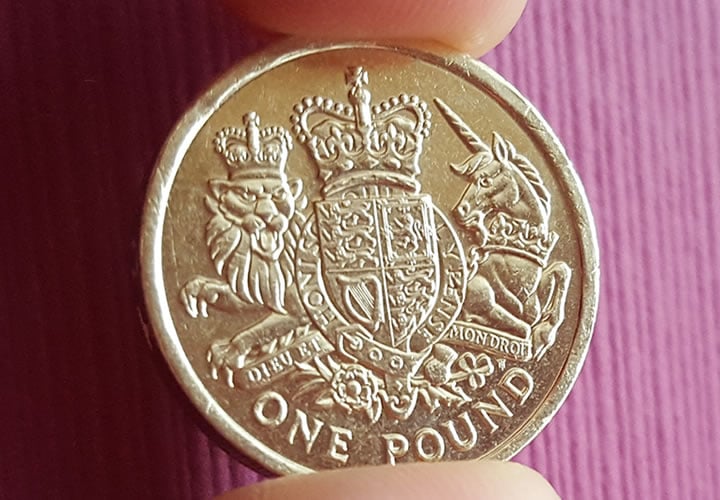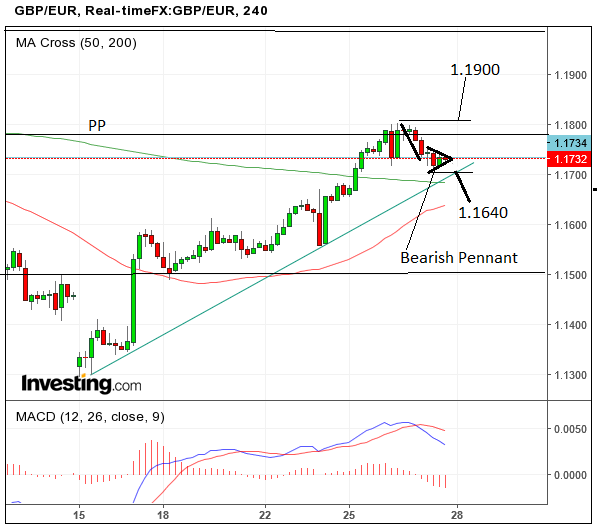UK GBP/EUR Exchange Rate's 5-Day Forecast: Super-Thursday Key Risk as Technicals Remain Bullish

It has been a positive start to the new week for Pound Sterling which has extended gains to trades at 1.1766 in the afternoon session of Monday, January 30.
GBP has risen for two weeks on the trot against the Euro, but as we sit on the cusp of a new week we are seeing mixed signals regarding the near-term outlook.
The short-term uptrend remains bullish but we believe only a break above the 1.1805 highs would see that trend confirmed and likely extended to the next round number at 1.1900.
So keep an eye on this important level going forward.
We are not all-out bullish on the pair as having risen through the course of the previous week, Friday 27 January saw GBP/EUR pull back from a test of the 1.18 area to fall to 1.1730.
This decline ruins what was quite a clean bullish prognosis for the exchange rate.
The exchange rate appears to have formed a bearish pennant as a result which strongly suggests another leg down, with an expected end-target at 1.1640.
We have noted on various occassions now that pennants have been quite useful at predicting movements in the Pound, so it will be interesting to see whether this trend continues in the week ahead.
The pattern comes in the form of a small triangular consolidation (the pennant) below a steep decline (its pole).
The pattern gets its name from the pennants which flew from the tops of castles in days of yore; except we have to picture it as being upside down in this scenrio.
That said, pennants are typically a bearish sign in a falling market, and as noted this is a bullish market over the multi-day timeframe.
Indeed, technical analyst Karen Jones at Commerzbank says she is wary of the Euro gaining ground this week having noted the single currency's six-month uptrend against Sterling stalled last week.
Jones is keeping an eye on 1.1829 as she believes a break above here in GBP/EUR could trigger further gains initially to 1.1886 and then 1.2042 which is the December high.
This number aligns quite nicely with our already-mentioned trigger at 1.1805.
Weakness is forecast to be shallow.
Inflation Data Dominates Calendar for the Single Currency
The main releases for the Euro will be CPI data on Tuesday at 10.00 GMT.
Headline inflation is expected to jump to 1.4% on rising fuel prices but Core Inflation will be the one to watch as it is likely to remain unchanged at 0.9%.
Only a surprise increase in Core along with rising headline would push the single currency higher.
If inflation beats expectations then it could well trigger Euro strength as markets bet that the case for the European Central Bank to fade its quantitative easing programme in 2017 grows more compelling.
Remember - for the Euro - this so-called tapering of quantitative easing is going to be the main theme of the year. Any suggestions that the programme is to be withdrawn will be positive for the Euro.
Other data includes the Unemployment Rate at, out at 10.00 GMT, which is expected to remain unchanged at 9.7%, and Q4 GDP released at the same time, which is forecast to show 1.7% growth year-on-year and 0.5% month-on-month.
More of the same steady growth is forecast.
Super-Thursday at the Bank of England Key to this Week's Agenda
The Pound could be the currency to supply the fireworks this week, with Thursday highlighted due to the BOE meeting and the release of the Quarterly Inflation Report.
There is potential for the Sterling to strengthen as recent above-forecast growth means the BOE will probably revise up their growth forecasts.
Of interest will be whether forecasts to the inflation profile are moved higher.
The strong consumption and stubbornly low unemployment means the BOE has more room to tackle rising inflation caused by the weak Pound and rising oil price.
This, in turn, could lead to heightened expectations of a BOE rate hike and a change of stance from neutral to more hawkish, which would propel Sterling higher.
Market pricing has moved increasingly hawkish, with just over 50% of a 25bp hike priced by the market to occur by year-end.
However, analyst Jack Di-Lizia at Deutsche Bank is sceptical the Bank will deliver any notable pro-Sterling noises.
"The MPC are likely to continue to stress downside risks while retaining a neutral bias as they allow Gilt QE to expire," says Di-Lizia.
Indeed, MPC commentary continues to focus on the merits of the Bank’s policy action taken in August as well as an emphasis on potential downside risks despite the continuing data momentum.
Nevertheless, some traders are bullish going into the event as they see a good risk-reward on betting that Mark Carney and his team will spring a pro-GBP surprise.
“We like buying pounds into the Quarterly Inflation Report, especially as it dips toward 1.25 with a target of 1.27/1.28,” says BK Asset Management’s Kathy Lien.
However, Sterling remains a political currency and we expect major moves to be framed by the Brexit story.
“It's strange to see GBP performing so well when the path towards a 'hard' Brexit remains firmly on the table; strategically, we remain bearish on GBP/USD and look for fresh catalysts (namely dollar strength) to see a short-term move back towards the 1.24 level,” says ING’s FX strategist Viraj Patel.
Also watch UK PMI data this week with manufacturing, construction and services PMI’s being released on Wednesday, Thursday and Friday respectively.
Manufacturing is expected to pull-back a basis point to 56.0, Construction forecast to 53.8 from 54.2 and Services to 55.8 from 56.2.






